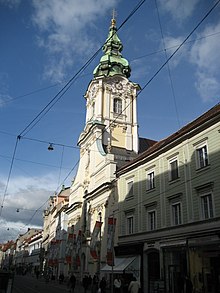Graz parish church
The Roman Catholic Church of the Holy Blood or the provost, main and city parish church of Graz-Hl. Blood , or Graz parish church for short, is located in the Inner City district of Graz . It is the parish church of the Graz-Hl. Blood in the dean's office Graz-Mitte of the city church Graz .
History and design


The first church in this place was built in 1440 at the suggestion of Emperor Friedrich III. built. This former Corporis Christi chapel was handed over to the Dominican Order a quarter of a century after its completion . From 1478 these expanded the small three-bay chapel by an elongated choir, it was not finished until 1520. Since the former parish church of St. Aegyd (today's Graz Cathedral ) was handed over to the Jesuit order and therefore a new parish church was needed, the Dominicans had to order in 1585 Archduke Charles II vacated their monastery for this purpose, and the Church of the Holy Blood was elevated to the status of the town parish church (St. Aegyd was the town parish church until 1573, and in 1786, after moving from Seckau, it became the cathedral of the diocese).
layout
While the main hall of the church is architecturally characterized by the Gothic style of the mendicant order , the facade was later designed in the Baroque style (for example, the roof turret with copper helmet, built according to the designs by Josef Stengg, dates from 1780). In the 19th century, the baroque altars were replaced by neo-Gothic ones. Only the baroque Johannes Nepomuk Chapel by Josef Hueber and the former high altar painting Mariae Himmelfahrt , which is attributed to the Venetian painter Tintoretto , have been preserved.
The Gothic glass windows were destroyed during the Second World War. Albert Birkle , a Salzburg artist whose art was considered degenerate in the Third Reich , was commissioned with the redesign . His main themes were the resurrection and suffering of Jesus, but his stained glass windows became a scandal in the 1950s because they show Hitler and Mussolini side by side with Christ's tormentors. Along with the St. Martin Abbey Basilica in Landshut , it is the only church in the world that shows the two dictators.
organ
The large organ was completed in 1970 by the organ builder Rieger (Vorarlberg). The slider chests -instrument has 46 registers on three manuals and pedal . The action mechanism is mechanical, the stop action is electrical.
|
|
|
|
|||||||||||||||||||||||||||||||||||||||||||||||||||||||||||||||||||||||||||||||||||||||||||||||||||||||||||||||||||||||||||||||||||||||||||||||||||||||||||||||||
literature
- Alois Kölbl, Wiltraud Resch: Paths to God. The churches and synagogue of Graz. 2nd, expanded and supplemented edition. Styria, Graz 2004, ISBN 3-222-13105-8 , pp. 93-96.
Web links
- Site of the parish church
- Information on the Graz parish church on westtravel.at ( Memento from November 11, 2014 in the Internet Archive )
- Images of the works of art in the church
Individual evidence
- ^ Hitler in the church window, accessed on May 9, 2009
- ↑ More information about the organ
Coordinates: 47 ° 4 ′ 9.3 ″ N , 15 ° 26 ′ 27.5 ″ E






